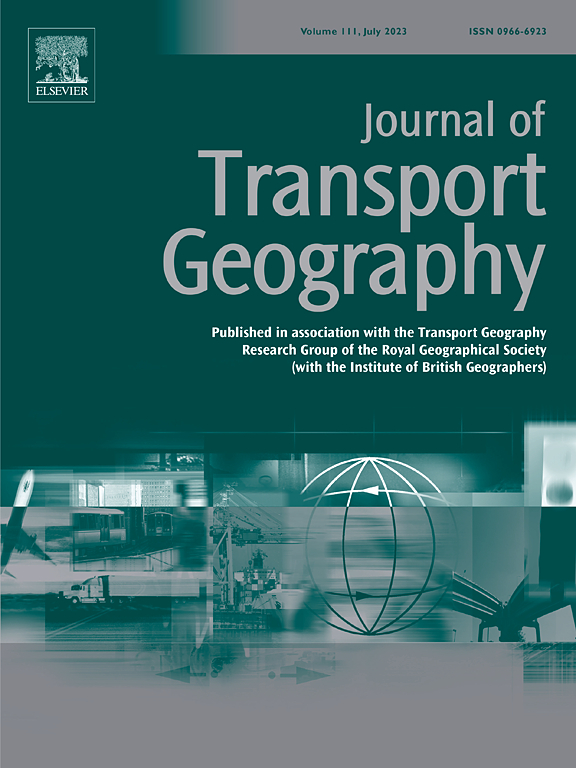Mining female commuter typology, commute cost and labor supply in Riyadh: a space-time investigation based on e-hail taxi data
IF 5.7
2区 工程技术
Q1 ECONOMICS
引用次数: 0
Abstract
Before 2018, Saudi Arabia was the only country that enshrined a legal prohibition on women driving. However, little has been done to empirically investigate the associations between female commute cost and labor supply before the driving ban was lifted. This is largely due to the data scarcity on disaggregated-level female mobility patterns and travel behaviors. To fill the gap, this study deployed a space-time framework to identify suspicious female roundtrip commuters whose majority of taxi trips were between home and workplaces based on about one million e-hailing O-D data from female passengers in Riyadh. Her commute costs (i.e., distance, time, out-of-pocket cost, commute burden) and labor supply information (i.e., work hours, skill-job mismatch) were then inferred by supplementing neighborhood-level Census data and open data on major female employers. Overall, female riders had significantly longer travel distance/time and higher out-of-pocket costs than male passengers. Though no causal statements were made, higher commute burden was related to lower Saudi female employment rate and longer working hours, while lower burden was associated with higher skill-job mismatch in terms of over-education, confirming our hypotheses that well-educated Saudi females might 1) choose not to work, 2) extend hours of work to offset travel costs, or 3) switch to nearby jobs with lower wage and skill-job match. Therefore, females’ restricted mobility became a non-negligible job market friction. Meanwhile, females worked in the manufacturing sector could pay more than 75% of her wages on e-taxis, implying a sector-specific spatial mismatch issue. Our findings provide a useful baseline on the female travel cost and labor supply situations before the lifting of driving ban. It enables comparative studies to understand the impacts of ongoing women empowerment for mobility and employment autonomy. The space-time framework also provides useful references for future research when gender-specific travel behavior surveys are not feasible.
挖掘利雅得女性通勤者类型、通勤成本和劳动力供应:基于电子出租车数据的时空调查
2018 年之前,沙特阿拉伯是唯一一个在法律上禁止女性驾车的国家。然而,在驾驶禁令取消之前,很少有人对女性通勤成本与劳动力供应之间的关联进行实证研究。这主要是由于缺乏女性流动模式和出行行为的分类数据。为填补这一空白,本研究采用时空框架,基于约 100 万条利雅得女性乘客的电子叫车 O-D 数据,识别出可疑的女性往返通勤者,她们的大部分出租车出行都是在家庭和工作地点之间。然后,通过补充社区一级的人口普查数据和主要女性雇主的公开数据,推断出她的通勤成本(即距离、时间、自付成本、通勤负担)和劳动力供应信息(即工作时间、技能-工作不匹配)。总体而言,与男性乘客相比,女性乘客的出行距离/时间明显更长,自付费用也更高。虽然没有因果关系的说明,但通勤负担较高与沙特女性就业率较低和工作时间较长有关,而通勤负担较低与教育程度较高的技能-工作不匹配有关,这证实了我们的假设,即受过良好教育的沙特女性可能会:1)选择不工作;2)延长工作时间以抵消旅行成本;或 3)转而从事附近工资和技能-工作匹配度较低的工作。因此,女性的流动性受限成为就业市场上不可忽视的摩擦因素。与此同时,在制造业工作的女性可以将 75% 以上的工资用于支付电子税,这意味着存在特定行业的空间错配问题。我们的研究结果为解禁前女性的出行成本和劳动力供给状况提供了一个有用的基线。通过比较研究,我们可以了解当前妇女赋权对流动性和就业自主性的影响。当针对不同性别的出行行为调查不可行时,时空框架也为未来研究提供了有用的参考。
本文章由计算机程序翻译,如有差异,请以英文原文为准。
求助全文
约1分钟内获得全文
求助全文
来源期刊

Journal of Transport Geography
Multiple-
CiteScore
11.50
自引率
11.50%
发文量
197
期刊介绍:
A major resurgence has occurred in transport geography in the wake of political and policy changes, huge transport infrastructure projects and responses to urban traffic congestion. The Journal of Transport Geography provides a central focus for developments in this rapidly expanding sub-discipline.
 求助内容:
求助内容: 应助结果提醒方式:
应助结果提醒方式:


